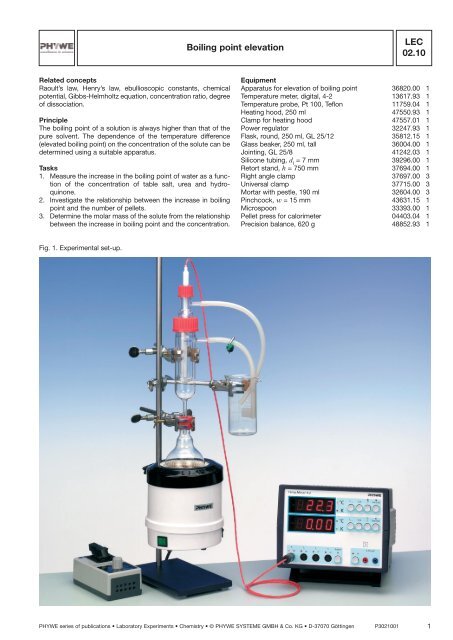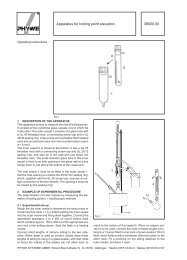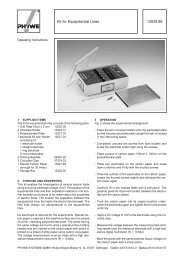LEC 02.10 Boiling point elevation - Phywe
LEC 02.10 Boiling point elevation - Phywe
LEC 02.10 Boiling point elevation - Phywe
You also want an ePaper? Increase the reach of your titles
YUMPU automatically turns print PDFs into web optimized ePapers that Google loves.
Related concepts<br />
Raoult’s law, Henry’s law, ebullioscopic constants, chemical<br />
potential, Gibbs-Helmholtz equation, concentration ratio, degree<br />
of dissociation.<br />
Principle<br />
The boiling <strong>point</strong> of a solution is always higher than that of the<br />
pure solvent. The dependence of the temperature difference<br />
(elevated boiling <strong>point</strong>) on the concentration of the solute can be<br />
determined using a suitable apparatus.<br />
Tasks<br />
1. Measure the increase in the boiling <strong>point</strong> of water as a function<br />
of the concentration of table salt, urea and hydroquinone.<br />
2. Investigate the relationship between the increase in boiling<br />
<strong>point</strong> and the number of pellets.<br />
3. Determine the molar mass of the solute from the relationship<br />
between the increase in boiling <strong>point</strong> and the concentration.<br />
Fig. 1. Experimental set-up.<br />
<strong>Boiling</strong> <strong>point</strong> <strong>elevation</strong><br />
<strong>LEC</strong><br />
<strong>02.10</strong><br />
Equipment<br />
Apparatus for <strong>elevation</strong> of boiling <strong>point</strong> 36820.00 1<br />
Temperature meter, digital, 4-2 13617.93 1<br />
Temperature probe, Pt 100, Teflon 11759.04 1<br />
Heating hood, 250 ml 47550.93 1<br />
Clamp for heating hood 47557.01 1<br />
Power regulator 32247.93 1<br />
Flask, round, 250 ml, GL 25/12 35812.15 1<br />
Glass beaker, 250 ml, tall 36004.00 1<br />
Jointing, GL 25/8 41242.03 1<br />
Silicone tubing, d i = 7 mm 39296.00 1<br />
Retort stand, h = 750 mm 37694.00 1<br />
Right angle clamp 37697.00 3<br />
Universal clamp 37715.00 3<br />
Mortar with pestle, 190 ml 32604.00 3<br />
Pinchcock, w = 15 mm 43631.15 1<br />
Microspoon 33393.00 1<br />
Pellet press for calorimeter 04403.04 1<br />
Precision balance, 620 g 48852.93 1<br />
PHYWE series of publications • Laboratory Experiments • Chemistry • © PHYWE SYSTEME GMBH & Co. KG • D-37070 Göttingen P3021001 1
Weighing dishes, 80 x 50 x 14 mm 45019.05 1<br />
Funnel, d o = 80 mm 34459.00 1<br />
Pasteur pipettes 36590.00 1<br />
Rubber bulbs 39275.03 1<br />
Wash bottle, 500 ml 33931.00 1<br />
Beads, 200 g 36937.20 1<br />
Sodium chloride, 500 g 30155.50 1<br />
Urea, pure, 250 g 30086.25 1<br />
Hydroquinone, 250 g 30089.25 1<br />
Glycerine, 250 ml 30084.25 1<br />
Water, distilled, 5 l 31246.81 1<br />
Vice<br />
Set-up and procedure<br />
Set up the experiment as shown in Fig. 1.<br />
Weigh the dry inner vessel of the boiling <strong>point</strong> apparatus and<br />
note the exact mass (= m 1 ). Fit the inner vessel into the outer<br />
vessel so that its inlet opening is located below the silicone rubber<br />
seal of the connecting cap. During measurement, steam is to<br />
enter the inner vessel through the lateral aperture, so pay attention<br />
that it is not covered. Fill the round flask with 150 to 200 ml<br />
of water and connect it to the assembled apparatus. Slip two<br />
short pieces of silicone tubing onto the two gas outlets of the<br />
outer vessel and place the lengths in a 250 ml glass beaker with<br />
the free ends at about the middle of the beaker. Attach a pinchclip<br />
to the lower of the two tubes coming from the outer vessel,<br />
but for the time being leave it open. Pour approximately 40 ml of<br />
water into the inner vessel. Close the vessel at the top by fixing<br />
the temperature probe in position.<br />
The substances to be tested must be pressed into pellets in<br />
order to prevent any particles of them from sticking to the walls<br />
of the vessel while being added. Weigh out five portions of each<br />
substance (NaCl, urea, hydroquinone), each of approximately<br />
700 mg. It is advisable to first pulverise the substances with a<br />
mortar and pestle. Use the pellet press as follows: Place it in a<br />
vertical position and put the small steel rod in the cylinder to<br />
close the bottom end of the borehole. Fill one portion of the substance<br />
into the hole using a funnel. Next insert the large rod from<br />
2<br />
<strong>LEC</strong><br />
<strong>02.10</strong><br />
Fig. 2: Example of a measurement: boiling <strong>point</strong> crease as<br />
function of concentration of table sal an aqueous solution<br />
P3021001<br />
<strong>Boiling</strong> <strong>point</strong> <strong>elevation</strong><br />
above and compress the substance a little. Fit the assembled<br />
press in a vice and apply pressure on it, so that a solid pellet is<br />
formed from the substance. Press the pellet out of the borehole<br />
with the longer rod.<br />
Weigh the pellets to an accuracy of 1 mg. The dependence of<br />
the boiling <strong>point</strong> <strong>elevation</strong> of water on the concentration can be<br />
demonstrated for each substance in a single experiment by successively<br />
adding known amounts of the same substance. Heat<br />
the solvent in the flask to boiling. The vapour evolved rises up<br />
into the outer vessel and heats up the inner vessel. Control the<br />
heating rate with the power control. The temperature in the inner<br />
vessel is displayed on the digital temperature meter in degrees<br />
Celsius. After some minutes, when the temperature in the inner<br />
vessel has nearly reached the boiling <strong>point</strong> and no longer<br />
increases, lower the heating hood for a few seconds until boiling<br />
stops and the condensate on the outer vessel returns to the<br />
round flask. Then raise the heating hood again. When boiling<br />
recommences, close the pinchcock. The (slightly superheated)<br />
steam now flows through the water in the inner vessel. Set the<br />
digital temperature meter to measure the change in temperature<br />
∆T over time with the tare function . In this mode of<br />
operation, the resolution is tenfold better (0.01 K). Wait until the<br />
value displayed remains constant. Now carefully open the inner<br />
vessel (screw cap), add the first substance pellet, and close the<br />
opening immediately. The temperature first drops slightly and<br />
then rises again while the pellet dissolves. When the value has<br />
again become constant, record it and repeat this procedure for<br />
the next portion of the substance. After five concentration steps<br />
have been measured, first open the pinchcock and then switch<br />
off the heating. This is important to avoid solution being sucked<br />
from the inner vessel into the flask containing water while cooling<br />
down. Remove the inner vessel, dry its outer surface, remove<br />
the temperature probe and re-weigh it. The mass of the water is<br />
now equal to the last measured value less the mass of the empty<br />
vessel and the masses of the five substance pellets. Plot the<br />
increase in boiling <strong>point</strong> against the quotient of the mass of the<br />
dissolved substance and the mass of water for each substance<br />
as shown in Fig. 2.<br />
Theory and evaluation<br />
A solution is a mixed-phase liquid which consists of a dissolved<br />
substance and a solvent. Only the solvent is capable of vaporization,<br />
the vapour pressure of the solute is practically zero.<br />
When a substance dissolves in a solvent, additional forces result<br />
and these must be overcome by solvent molecules before they<br />
can pass into the gas phase. Less solvent molecules can therefore<br />
vaporize from a solution than from the pure solvent. In 1886,<br />
F. M. Raoult postulated the law that is named after him: The<br />
vapour pressure of a solution is given by the product of the<br />
vapour pressure of the pure solvent and the mole fraction of the<br />
solvent.<br />
where:<br />
ps p0 n1 n2 n 2<br />
Ps · p0 n1 n2 Vapour pressure of the solution<br />
Vapour pressure of the pure solvent<br />
Amount of the pure solvent<br />
Amount of dissolved substance<br />
A liquid boils when its vapour pressure is the same as the ambient<br />
pressure. The vapour pressure of water reaches an ambient<br />
pressure of 1013 hPa at a temperature of 100°C. When a substance<br />
is dissolved in water, the vapour pressure is reduced, and<br />
is so less than 1013 hPa at 100°C. Heat must now be supplied<br />
PHYWE series of publications • Laboratory Experiments • Chemistry • © PHYWE SYSTEME GMBH & Co. KG • D-37070 Göttingen<br />
(1)
to increase the kinetic energy of the molecules, and so to raise<br />
the temperature so that the solution comes to boiling. The reason<br />
for the higher energy requirement for the solution than for<br />
the pure solvent is because additional forces, mutual attractive<br />
forces between solute and solvent, must be overcome in the<br />
solution. The solution does not boil at T 0 , but at the higher temperature<br />
T s . The difference between these two temperatures is<br />
the boiling <strong>point</strong> <strong>elevation</strong> ∆T s .<br />
∆T s = T s - T 0 (2)<br />
From a quantitative <strong>point</strong> of view, the boiling <strong>point</strong> <strong>elevation</strong> is<br />
dependent on the amount to which the vapour pressure is lowered,<br />
and so on the concentration of the solute. Molality is used<br />
here as dimension, i.e. the number of moles of solute dissolved<br />
in 1 litre of solvent.<br />
m1 m2 M2 Ke ∆T K e · m 2 · 1000<br />
M 2 m 1<br />
Mass of the pure solvent<br />
Mass of the dissolved substance<br />
Molar mass of the dissolved substance<br />
Ebullioscopic constant<br />
<strong>Boiling</strong> <strong>point</strong> <strong>elevation</strong><br />
(3)<br />
When determining the relative molar mass of a dissolved substance,<br />
the fact that the number of free moles n B corresponds to<br />
the number of free particles must be taken into account. If, however,<br />
n B moles dissociate into z smaller particles in solution, then<br />
the number of moles actually present becomes<br />
n = n B (1 + (z – 1) a) (4)<br />
where a is the degree of dissociation.<br />
Under certain conditions, the determination of molar masses<br />
using ebullioscopy can therefore only supply the apparent molar<br />
mass M s , which must then be converted using<br />
M s <br />
Data and results<br />
K e (water) = 0.515 K · kg · mol -1<br />
M B<br />
11 1z 12 a2<br />
Molar masses (in g · mol -1 ):<br />
NaCl (a = 1, z = 2): 61.71 (exp.); 58.44 (lit.)<br />
Urea (a = 0): 60.83 (exp.); 60.06 (lit.)<br />
Hydroquinone (a = 0): 108.14 (exp.); 110.11 (lit.)<br />
<strong>LEC</strong><br />
<strong>02.10</strong><br />
PHYWE series of publications • Laboratory Experiments • Chemistry • © PHYWE SYSTEME GMBH & Co. KG • D-37070 Göttingen P3021001 3<br />
(5)
4<br />
<strong>LEC</strong><br />
<strong>02.10</strong><br />
P3021001<br />
<strong>Boiling</strong> <strong>point</strong> <strong>elevation</strong><br />
PHYWE series of publications • Laboratory Experiments • Chemistry • © PHYWE SYSTEME GMBH & Co. KG • D-37070 Göttingen
















